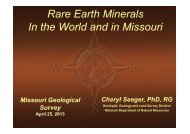You also want an ePaper? Increase the reach of your titles
YUMPU automatically turns print PDFs into web optimized ePapers that Google loves.
coarse-gra<strong>in</strong>ed granite (QAP: 30% Q, 40% A, 30%<br />
P) at this location is weakly enriched <strong>in</strong> some of the<br />
HREE (Sample 20120921BG-7).<br />
big creek district<br />
The Big Creek pegmatite district, on the west side<br />
of the Medic<strong>in</strong>e Bow Mounta<strong>in</strong>s, was <strong>in</strong>vestigated<br />
and mapped by Houston (1961) and covers an area<br />
several miles wide and 3.2 to 10 km (2 to 6 mi)<br />
south of the Mullen Creek-Nash Fork shear zone<br />
(fig. 8). The Mullen Creek-Nash Fork shear zone<br />
is part of the Cheyenne belt suture, which represents<br />
a cont<strong>in</strong>ental-arc collision zone (Graff, 1978;<br />
Hills and Houston, 1979) separat<strong>in</strong>g the Wyom<strong>in</strong>g<br />
Prov<strong>in</strong>ce to the north from cratonized (1.7 Ga)<br />
Proterozoic basement of the Colorado Prov<strong>in</strong>ce<br />
to the south. The Colorado Prov<strong>in</strong>ce south of the<br />
Cheyenne belt consists of volcanogenic island-arc<br />
basement rocks, <strong>in</strong>trusive granites, and gabbroic<br />
complexes. The Mullen Creek complex, one of<br />
the larger layered mafic complexes <strong>in</strong> the western<br />
United States, lies along the northern edge of the<br />
Big Creek pegmatite district. The district is <strong>in</strong>cluded<br />
with<strong>in</strong> the Prelim<strong>in</strong>ary Geologic Map of<br />
the Saratoga 30’ x 60’ quadrangle (Sutherland and<br />
Hausel, 2005).<br />
Two types of granite pegmatite were described<br />
by Houston (1961) that cut Early Proterozoic<br />
amphibole gneiss <strong>in</strong> close proximity to both a<br />
medium- to coarse-gra<strong>in</strong>ed, p<strong>in</strong>k to gray foliated<br />
granite <strong>in</strong>trusion, and a well-foliated amphibolite<br />
of the 1778 ± 2 Ma, Mullen Creek layered mafic<br />
igneous complex. In the vic<strong>in</strong>ity of known REE<br />
occurrences, the amphibole gneiss is dom<strong>in</strong>ated by<br />
hornblende gneiss and schist, with lesser, alternat<strong>in</strong>g<br />
layers of feldspar-quartz-biotite gneiss.<br />
The most common pegmatite is an unzoned<br />
feldspar-quartz type that is roughly conformable<br />
<strong>in</strong> direction and attitude to the amphibole gneiss.<br />
These pegmatites tend to be long and narrow, with<br />
widths <strong>rare</strong>ly greater than 3 m (10 ft) and lengths<br />
exceed<strong>in</strong>g 0.8 km (0.5 mi). Their contacts with the<br />
country rock are sharp and exhibit no decrease <strong>in</strong><br />
gra<strong>in</strong> size toward the contacts. M<strong>in</strong>eralogy is simple<br />
and is dom<strong>in</strong>ated by feldspar accompanied by m<strong>in</strong>or<br />
quartz and accessory biotite, muscovite, garnet,<br />
magnetite, and ilmenite (Houston, 1961).<br />
29<br />
The second type of pegmatite may have poorly developed<br />
zon<strong>in</strong>g, has cross-cutt<strong>in</strong>g relationships with<br />
the amphibole gneiss, and tends to be elliptical <strong>in</strong><br />
plan view, with lengths averag<strong>in</strong>g three times their<br />
widths. Similar to the first type, these pegmatites<br />
have sharp contacts and show no decrease <strong>in</strong> gra<strong>in</strong><br />
size toward contact with the country rock. However,<br />
the m<strong>in</strong>eralogy is more complicated, and along<br />
with feldspar and quartz, <strong>in</strong>cludes garnet, biotite,<br />
muscovite, tourmal<strong>in</strong>e, fluorite, and <strong>rare</strong> monazite,<br />
allanite, euxenite, and columbite (Houston, 1961).<br />
Economically, these pegmatites can be described<br />
as either copper-bear<strong>in</strong>g or REE-bear<strong>in</strong>g. Houston<br />
(1961) noted five pegmatites <strong>in</strong> the district that<br />
are known to host one or more of the REE-bear<strong>in</strong>g<br />
m<strong>in</strong>erals, monazite, allanite, and euxenite. However,<br />
only the Platt pegmatite conta<strong>in</strong>ed economic<br />
quantities of these m<strong>in</strong>erals. Numerous other<br />
pegmatites <strong>in</strong> the district were not exam<strong>in</strong>ed and<br />
have the potential to host REE m<strong>in</strong>eralization<br />
(K<strong>in</strong>g and Harris, 2002). The nearby Big Creek<br />
m<strong>in</strong>e hosted copper m<strong>in</strong>eralization, but no primary<br />
REE m<strong>in</strong>erals or columbite. Columbite [(Fe,Mn)<br />
(Nb,Ta) 2 O 6 ] may conta<strong>in</strong> REE and uranium as<br />
accessory constituents (K<strong>in</strong>g and Harris, 2002;<br />
M<strong>in</strong>Dat.org, 2011).<br />
Platt M<strong>in</strong>e (Platt Pegmatite, Uranium K<strong>in</strong>g<br />
M<strong>in</strong>e), SW¼SE¼ sec. 3, T. 13 N., R. 81 W.,<br />
Southeastern Carbon County<br />
The Platt m<strong>in</strong>e was excavated to a depth of 23 m<br />
(75 ft) <strong>in</strong> a zoned, cross-cutt<strong>in</strong>g type pegmatite 21<br />
m wide by 49 m long (70 x 160 ft). The outer part<br />
of the pegmatite is feldspar, and the central part<br />
is quartz-mica-feldspar-<strong>rare</strong> <strong>earth</strong> m<strong>in</strong>erals. Euxenite<br />
is the most abundant REE-bear<strong>in</strong>g m<strong>in</strong>eral<br />
followed by monazite, and the least abundant,<br />
columbite (Houston, 1961). These occur as large<br />
<strong>in</strong>dividual crystals and crystal aggregates both <strong>in</strong><br />
the central pegmatite and <strong>in</strong> gash fractures. Uranium<br />
accounted for most of the production from<br />
the Platt m<strong>in</strong>e <strong>in</strong> 1956 with 12 tonnes (13 tons) of<br />
ore (K<strong>in</strong>g and Harris, 2002). Approximately 4,500<br />
kg (10,000 lbs) of euxenite were reported to be<br />
extracted from the m<strong>in</strong>e between 1956 and 1958<br />
(Houston, 1961; Adams and others, 1980), although<br />
the USBM recorded only 1,413 kg (3,115



